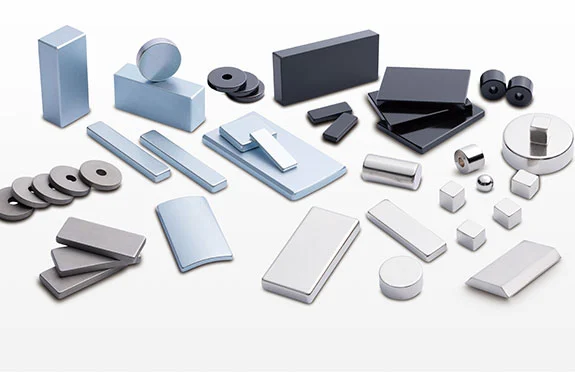May 06 , 2025
Sintered NdFeB magnets are produced using powder metallurgy techniques. The alloy, after melting, is processed into powder and then aligned and compacted in a magnetic field to form a green compact. The compact is sintered in an inert atmosphere or vacuum to achieve densification. To enhance the coercivity of the magnet, aging heat treatment is typically required. The production of sintered NdFeB mainly involves the following key steps:
This is the first step in the production of sintered NdFeB. The furnace temperature is raised to approximately 1300 °C and maintained for about four hours. Raw materials are melted and then rapidly cooled to form alloy ingots or flakes, preparing the material for the next processing stage.
The purpose of this step is to crush the alloy ingots into fine powder. Advanced powder preparation methods include hydrogen decrepitation and jet milling. To produce high-performance magnets with good crystal alignment, the powder particles must be small (typically 3–4 μm), have a narrow size distribution, and exhibit spherical or near-spherical shapes.
Magnetic alignment of the powder is one of the most critical technologies for manufacturing high-performance sintered NdFeB magnets. After placing the milled powder into a mold, an external magnetic field is applied to align the powder particles. The aligned powder is then compacted. Common compacting methods include die pressing, die pressing followed by cold isostatic pressing, and rubber mold isostatic pressing.
The relative density of the green compact is high, but the contact between powder particles is mechanical and weak. To improve density, enhance interparticle bonding, and develop the desired microstructure for high-performance permanent magnets, the compact is heated to a temperature just below the melting point of the primary phase for a set period—this is the sintering process.
Post-sintering heat treatment is crucial for enhancing the coercivity of the material. Aging can be performed using a single-step or two-step process. Single-step aging is cost-effective and fast, but results in lower performance and reduced consistency. The two-step aging process yields better magnetic properties and is widely adopted in the industry.
After sintering, sintered neodymium magnet is machined to meet specific dimensional and shape requirements. Due to their brittleness and hardness, precise machining techniques are required.
To improve corrosion resistance and appearance, sintered neodymium magnet is usually coated with a protective layer. Common plating options include nickel, copper, multilayer nickel-copper-nickel, or zinc coatings.

